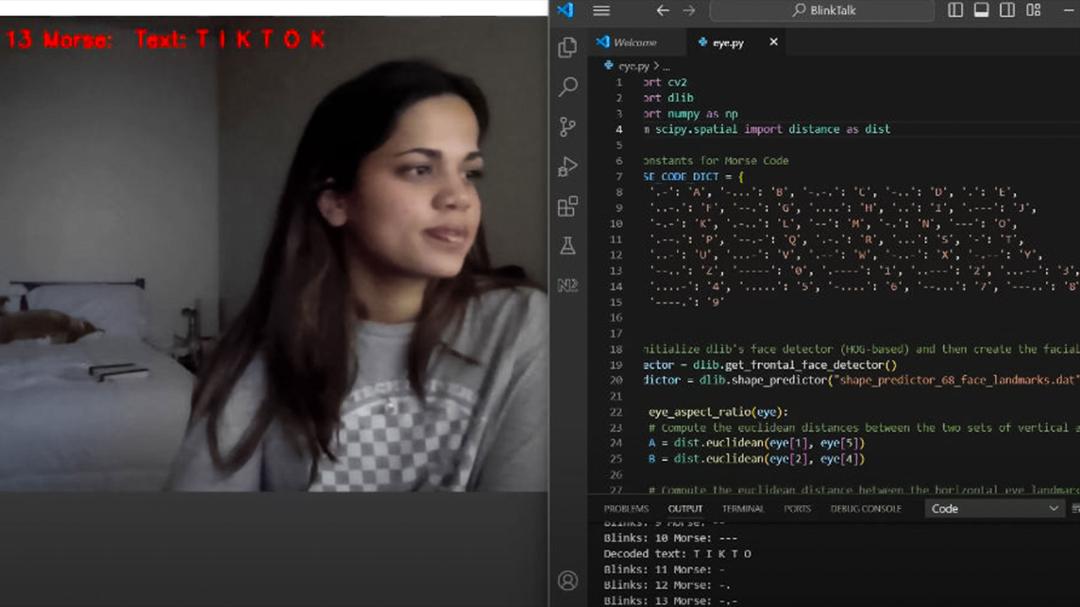Inspired by a scene from “Grey’s Anatomy,” this international student devotes her free time to developing software that will translate blinks as Morse code into English text.
Jason Castor lay wide-eyed, neck brace in place with a ventilator protruding from his mouth.
He listened to the soft voice above him – a doctor informing him about the accident he had suffered and the two options he had left. The questions were hard enough to consider besides the fact he couldn’t speak or move below his neck.
Jason could remain hooked to a breathing machine indefinitely or say goodbye to his wife as she provided him affirmation and reassurance. But words were impossible to form, and with a well of tears and a gentle nod, his decision was made without parting words.
Shruti Nagawekar, a spectator of this heartbreaking scene, had to remind herself “Grey’s Anatomy” is a medical drama television series – not reality.
“In that moment, I was just devastated because I was putting myself in his shoes,” she said. “I would be devastated if I couldn’t tell my loved ones I love them in my final moments. In general, autonomy is important to everybody. And in that moment, I was like, ‘I wish I could do something for that person and people like him.’”
It just so happened to be the perfect time to meet such a challenge, as it was summer break 2024 for Shruti. Without the demands of homework and upcoming tests she would face as a fourth-year computer engineering major at Texas Tech University, she delved into researching communication methods for quadriplegics.
Along the way, she remembered another powerful moment she had witnessed of an American soldier who was a prisoner of war (POW) of the North Vietnamese in 1966. When he was interviewed by a Japanese reporter as part of a televised propaganda campaign, he blinked in Morse code, “T-O-R-T-U-R-E.” This sent a clear message to the U.S. military about the harsh treatment of American POWs.
“I was like, ‘I need to use what I know, that is computer vision, to actually bring these two ideas together and help quadriplegic patients,’” she remembered.
Computer vision is the science and technology used to train machines how to understand, analyze and interpret visual information the same way humans do. Shruti believed she could use this technique to track and count eyeblinks and convert them from Morse code into English text directly onto a screen.
This could seem like a daunting task to some, but Shruti’s goal is to become a machine-learning artificial intelligence (AI) engineer one day. She even enrolled in a graduate-level class that summer semester to learn about image processing with AI.
“I’m doing everything in my power to become the best in the field so that I get a job as a machine-learning AI engineer once I graduate next year,” she said.
To get started, Shruti trained her systems to not only detect eye movements, but also to distinguish the speed of the blink to determine a dot versus a dash. After a week spent learning from online resources, asking any questions that arose to fellow developers on forums and even ChatGPT, she built a software called BlinkTalk.
Eager to share her creation, Shruti recorded a demo video in which she used 13 blinks to spell “TIKTOK.” She was pleased to see her post on LinkedIn gathered more than 100 likes and several encouraging comments from peers, faculty and even industry professionals.
“That made me extremely happy to get validation that they approved of my work,” she said. “Most all the reactions were supportive and in awe, saying things like, ‘Wow, this is a great product.’”
Before long, Shruti even had a potential co-investigator express interest in the project. But by the next month, her summer free time had run out as she began to juggle her fall semester responsibilities.
Although Shruti is in the midst of this break from BlinkTalk, it is still in the forefront of her mind. She plans to collaborate with a friend to ensure the software is available as a smartphone app. Another step she would like to pursue is meeting a quadriplegic to improve the software through their feedback.
“This is my passion project,” she noted. “It’s my baby, and I want to make sure it’s on the right path.”
It says something about Shruti’s character that her top priority the moment she has bandwidth is a project focused on others. BlinkTalk has become the most rewarding way to spend her free time in a foreign country away from her family and life as she knew it in India.
Shruti hasn’t seen her parents in two and a half years – an emotional toll heightened by the fact she’s an only child. But Shruti refuses to let homesickness distract from relinquishing her lifelong dream to take her talents overseas and make a difference.
Inspired in India
This journey truly began for Shruti in the 10th grade, when she had to pick a study concentration as is custom in India. Her three options were to become a doctor, a lawyer or an engineer.
For her, the decision was an easy one. She did not like biology, so no medical field for her. And in her words, “law memorization wasn’t my thing.”
That left engineering.
Shruti decided to enroll in a computer science class the following year and immediately enjoyed how the subject was based on logic. She explains herself as someone who can envision different possibilities, which is considered a strong skillset in that field.
“I was naturally good at computer science,” she recalled, “and when you’re naturally good at something, you love it.”
Beyond that, Shruti found another passion by exploring new ground through research. She became fascinated by the chance to determine what resources she would need to pave the way to an improved future.
She just needed a university in which to embed herself to do such work, preferably in the U.S. (which she calls the perfect land for dreamers). That task required Shruti and her family to hire aides who could help them navigate her options.
After they narrowed her list down to five universities, Shruti began to research each one to determine which would be her best option. She came to the same conclusion as her aides: Texas Tech and its classification as a “Tier One” Very High Research Activity university made it a perfect match for her.
Shruti’s enrollment meant the start of an academic adventure that would change the trajectory of her life. She was justifiably overjoyed – that is, until she became overwhelmed with the uncertainties that accompanied the COVID-19 pandemic in 2021.
As an Indian citizen, Shruti would require an F-1 visa to study abroad, but the regulations in place at the time prevented the U.S. from conducting any visa interviews. Just like that, her dream was put on hold indefinitely.
“Everything seemed like it was just falling apart,” Shruti recalled of the debacle.
But then, a beacon of hope shone from a message she received on her phone. Emergency visa interview slots were open, and she immediately booked hers.
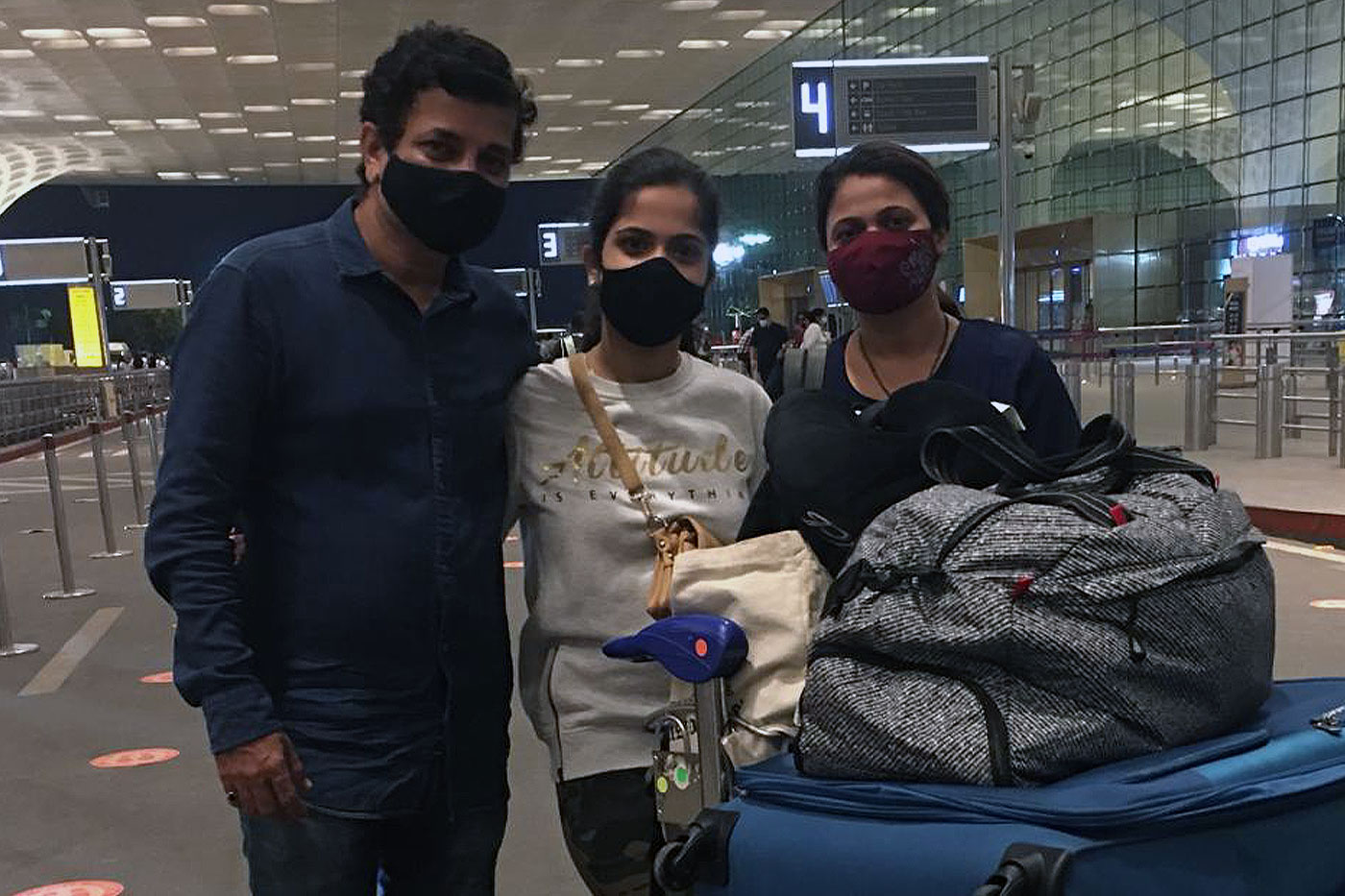
Within a month, Shruti was relieved to board a plane and begin her long-awaited move to Lubbock. She had more than 30 hours to realize the distance she was placing between herself and her family.
“You are away from your family for the very first time, so your heart is literally breaking into pieces,” she recounted. “That night, I felt like my heart was being ripped out and there was nothing I could do to stop it.”
Physically and mentally exhausted, Shruti needed to see her first sunset on the Texas Tech campus to become rejuvenated – a memory still enchanting to this day.
Transfixed by Texas Tech
Shruti was standing at Holden Hall during golden hour, those precious twilight minutes when she describes the light as cozy. About that time she turned around and faced the Administration Building, her jaw dropping at the sight.
Before her was the postcard scene she saw countless times while learning about Texas Tech online. The outstretched Spanish Renaissance building with its signature bell towers like bookends was no longer out of reach behind a screen, but right in front of her eyes – framed by the trees of Memorial Circle with the flags of Texas Tech and the new state and country she would reside in for the next four years waving overhead.
“It was just a mesmerizing moment,” Shruti reminisced. “Every time I think about it, I just get so happy.”
From that moment Shruti truly began to explore college life. Newfound friends encouraged her to leave her dorm room and join them at different Raider Welcome events that familiarized them to their surroundings. She steadily grew her inner circle even further through her involvement on campus.
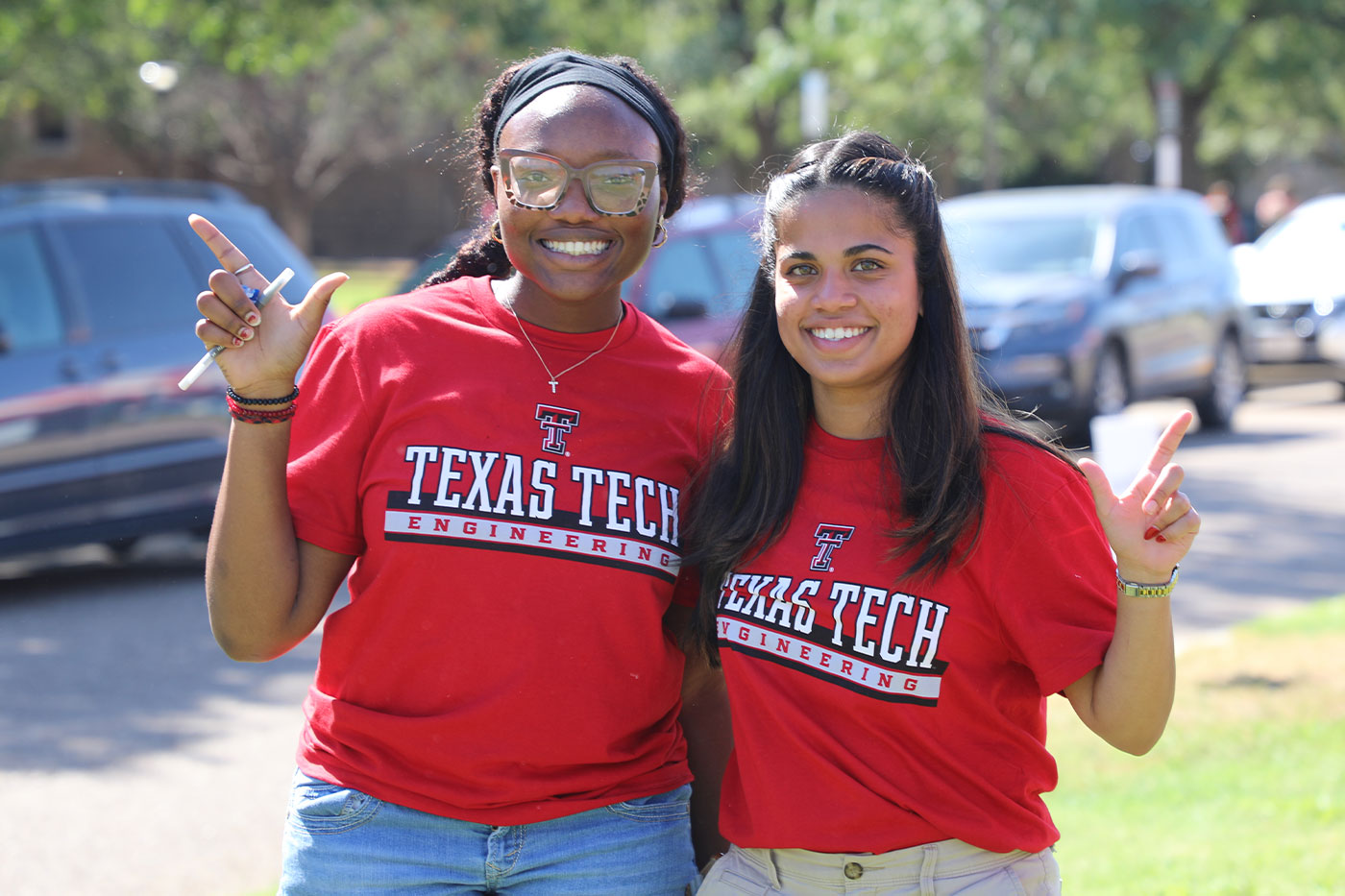
Shruti found her classes covered familiar content, but the workload was much different than back home, with frequent assignments and exams that required much more dedicated study time.
“In India, that didn’t happen,” she explained. “We would have three exams and one final exam, and that’s about it – not daily assignments like we do here. That was a big shock, and it took some time for me to get use to the system.”
Thankfully, Shuti built a critical support system through several different student organizations such as the Transformative Undergraduate Experiences (TrUE) Scholars, the HackWesTX student-run hackathon and Google Developer Student Club (eventually serving in officer positions for the latter).
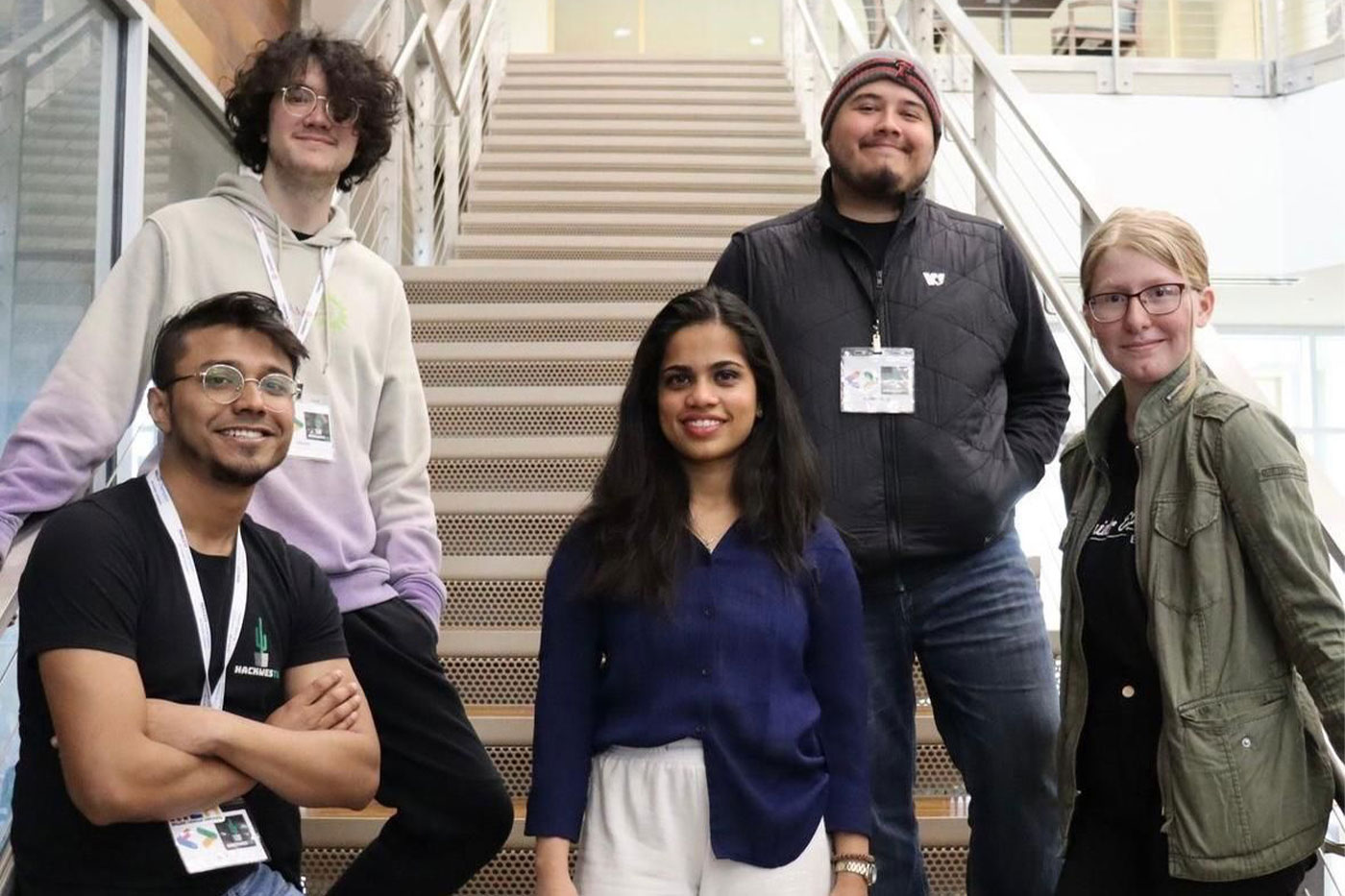
Shruti was elated to complete research on the side during her undergraduate studies through TrUE Scholars, which recruits, trains and supports talented first-year Texas Tech students through the entire continuum of Undergraduate Research and Creative Activities. A project she became particularly proud of is titled “Non-Contact Fall Detection and Vital Signs Monitoring” in which she explored using radar technology to advance fall detection and vital signs monitoring systems for older adults that would eliminate the need for physical contact.
Her participation with the HackWesTX hackathon also gave her the chance to co-found a startup called CardReward, which is software she helped design that uses a Chrome extension to advise which credit card would maximize cash back for each purchase.
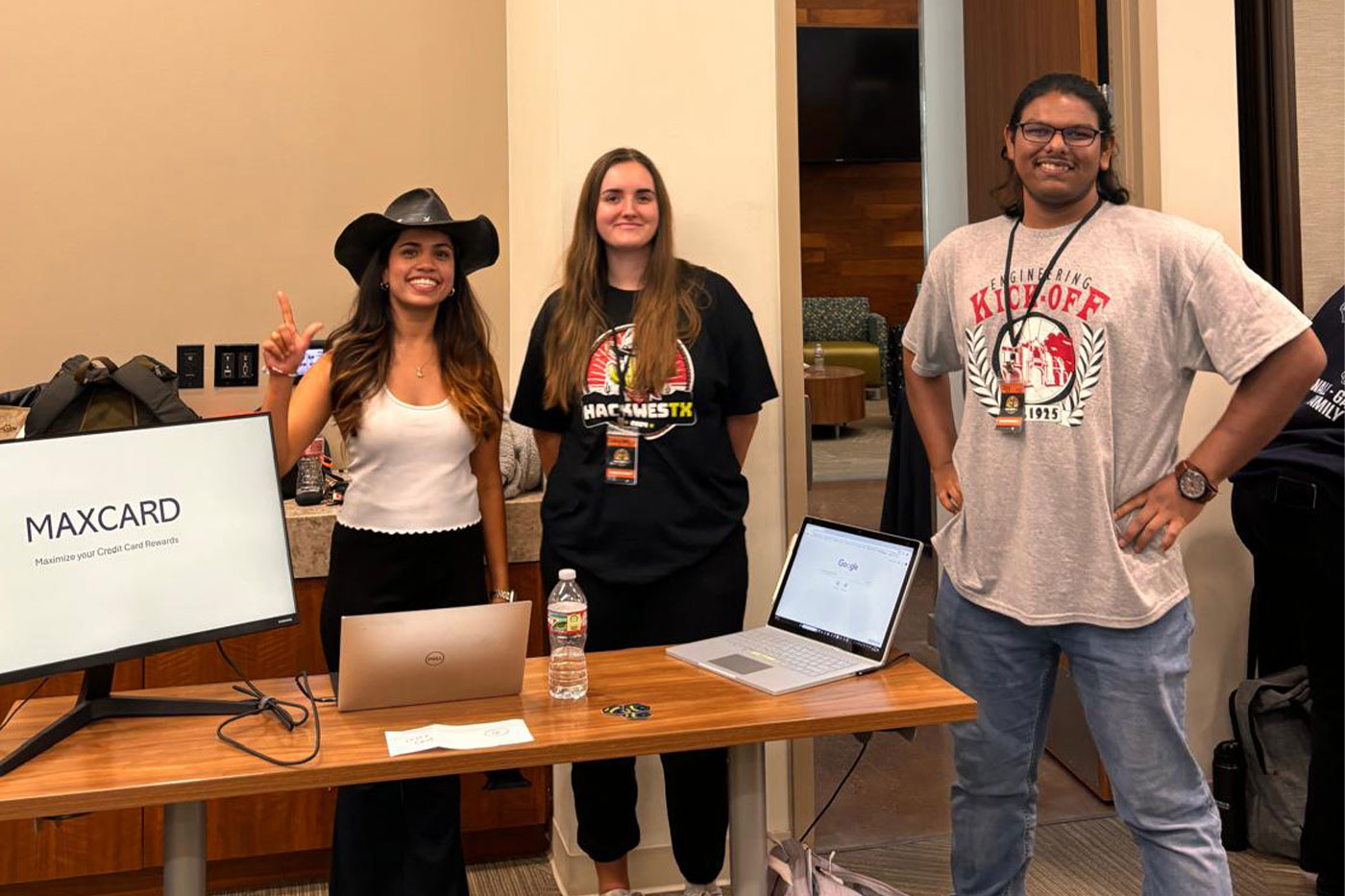
“These projects have allowed me to build skills in radar technology, computer vision, web scraping and data analysis,” she said. “They reflect my passion for applying technology to real-world challenges and have put me ahead of the crowd, because I’m doing research as an undergrad, which is rare. I’m 21 and I have two years of research experience – not many people can say that.”
Shruti’s expectations were exceeded even more when, halfway through her degree, she changed her major to computer engineering and became a part of Project Lab. This four-semester sequence challenges students to complete an open-ended project without the aid of instruction. Shruti describes the assignment as being thrown into a pool with teammates to see if they can swim.
One of her assignments was to make a rover that could compete in a penalty shootout soccer competition and also defend the ball. She credits these lab hours for providing her with a year’s worth of hands-on experience students at many other universities do not gain.

“I get the best opportunities out there, whether it be research or professors who teach amazing cutting-edge technology to me every day through labs and different classes,” she remarked. “I do believe that through pushing me as an engineer every day, Texas Tech has set me up for success.”
This passion drove Shruti to become an active member of Engineering Ambassadors and also the Launch Your Future in Engineering mentor program that paired her with a first-year mentee she has assisted through challenges often faced in the college and engineering community.
It’s no wonder Derek Johnston, a lecturer of electrical and computer engineering, considers Shruti one of the few students who is a constant presence in the Edward E. Whitacre Jr. College of Engineering.
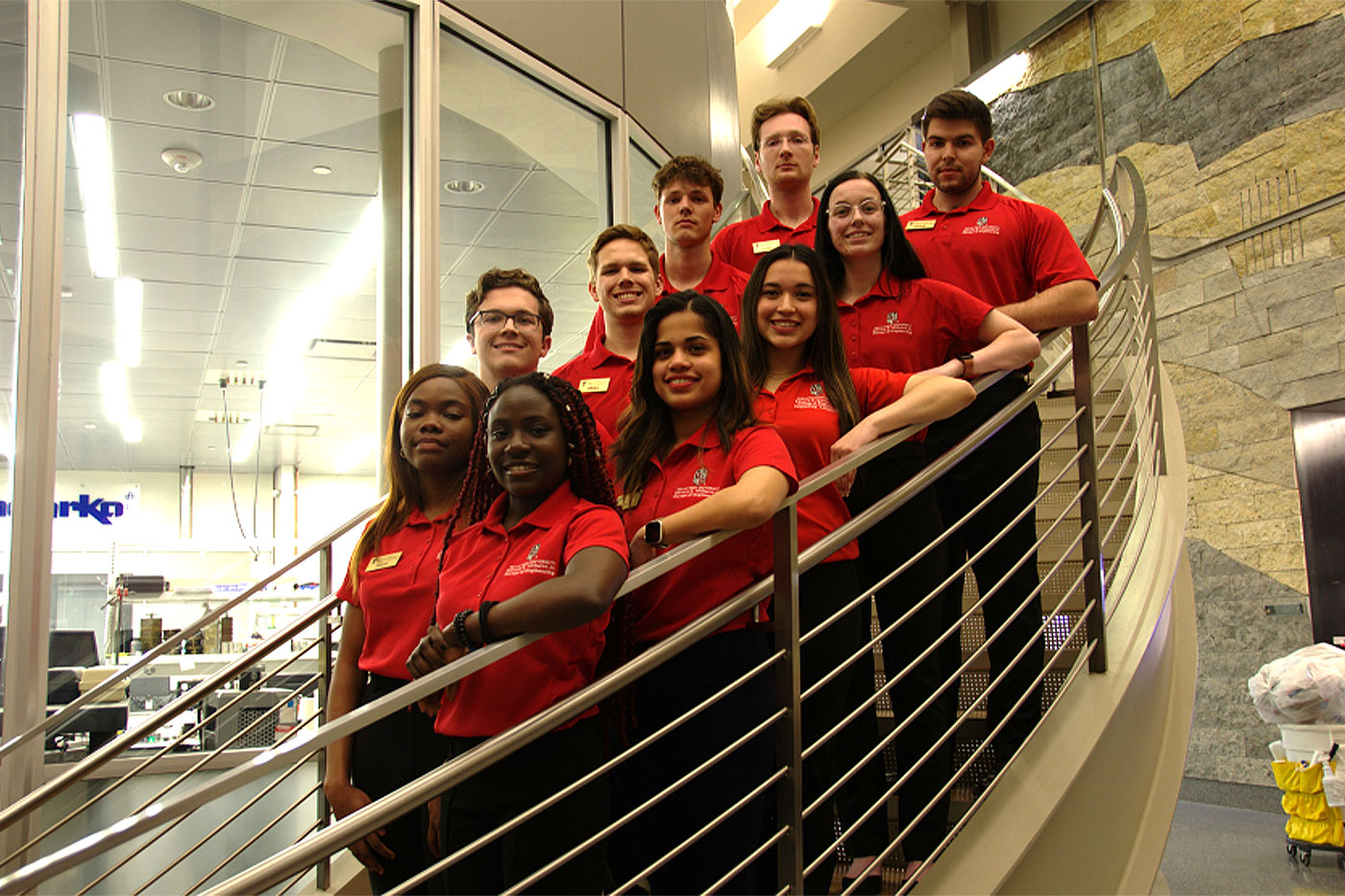
“Everyone knows who these students are and that they’re an awesome resource,” he praised. “They have a reputation for constantly being available to help out, and Shruti is definitely part of that group.”
As TrUE’s lead administrator for communications & partnerships, Jacy Enloe picked up on Shruti’s selflessness from her first year on campus. She was impressed by how Shruti worked as many hours as she could and remained a go-getter, but as one of her mentors, Enloe encouraged Shruti not to overcommit to responsibilities.
Shruti chose to heed this advice and found balance by cutting down on her leadership positions. But what has not slowed, by any means, is her spirit to assist those around her.
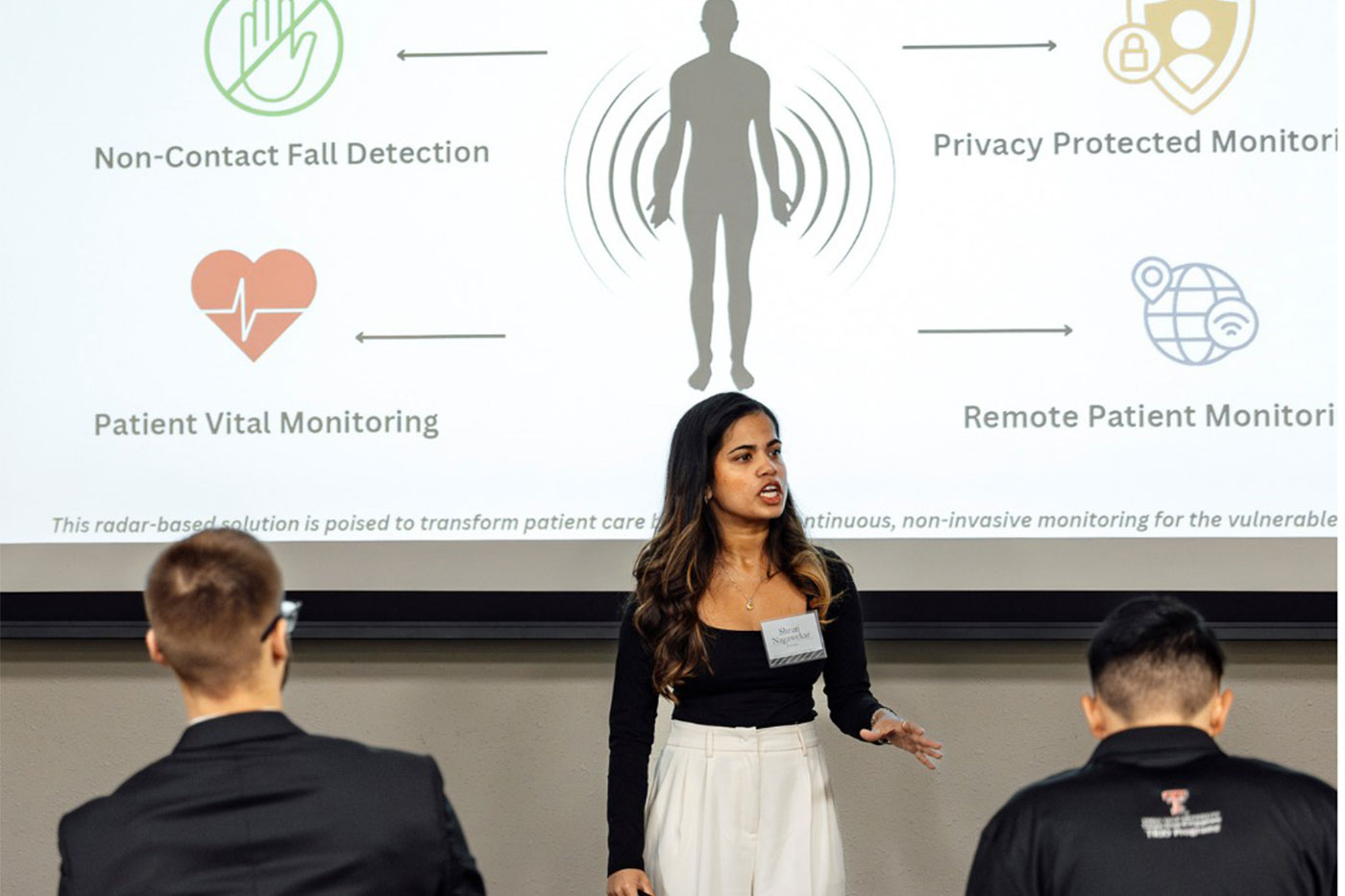
“She’s someone we can count on if we hire new students and need someone to show them the ropes,” Enloe acknowledged. “Or if someone is wanting us to come and talk to a group of students about undergraduate research, which is mostly what our office does, she’s a perfect candidate because she’s been involved in so much.”
It wasn’t that long ago that Shruti herself felt overwhelmed by the college education system. She regularly attended office hours of her professors and sought help from upperclassmen to gain the understanding she needed to get the most out of her degree.
Now, she has made it her global mission to pay that knowledge forward not only through tutoring but through her social media platform.
Mentor to Many
Shruti still recalls herself as a ninth grader in India, watching YouTube videos featuring students from her country studying abroad in the U.S.
She clung to their words of advice and used their experiences to map out her own plan. But she couldn’t help noticing a trend with her virtual role models.
“It was mainly boys giving advice,” she noted. “There were no girl international students.”
After discussing this trend with her mom, who is her biggest supporter, they both agreed Shruti should document her path to study in the U.S. and share her videos online so others like her could envision their way ahead.
“I knew I had to fill in the gap because it’s different for girls than boys in certain aspects,” she reasoned. “Having somebody who looks like you give advice makes you feel better, so that was my motivating factor to start sharing my experiences of being an international student.”
Her parents are open-minded, but Shruti recognizes others back home aren’t. Female students are less likely to be permitted to study abroad for their undergraduate degree because of safety concerns.
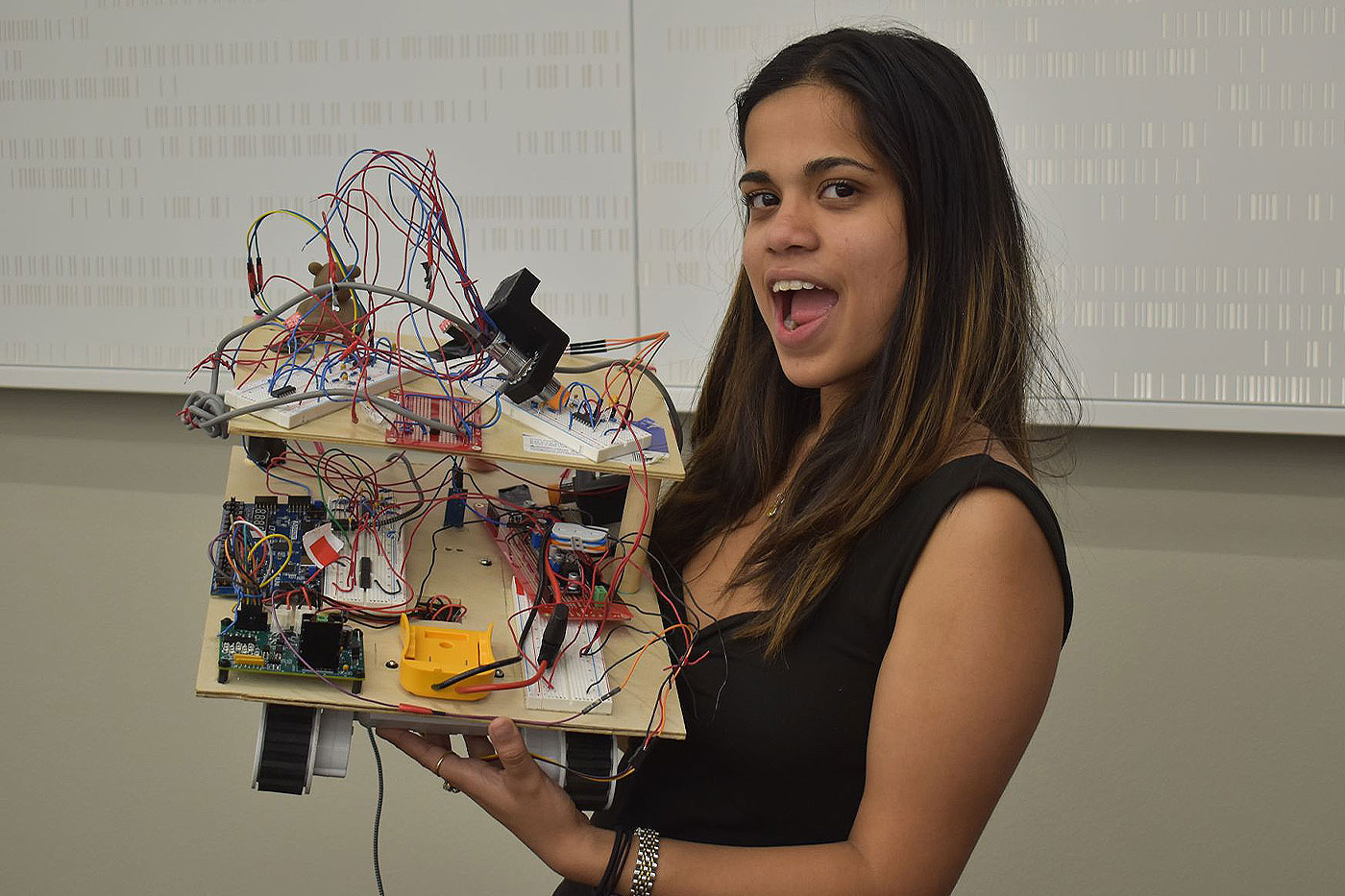
If she could build an online platform that showed her as a Texas Tech student, it could open doors to similar possibilities for others.
“I am a testament that your daughter can come here and be safe and be successful at the same time,” she shared. “So, what I do is important for other people’s dreams as well. That’s why I try to be on social media as much as I can, because many girls are going to use me as their argument that, ‘If she can go, then, why can’t I?’”
From the time Shruti prepared for and took the Test of English as a Foreign Language (TOEFL), to explaining what transcripts are and what to pack as an international student, she made sure to document it all. She even recorded the special moments she received her acceptance to Texas Tech all the way to her first snow day on campus.
She admits she does not have as much capacity to edit full-length videos as she did three years ago, but Shruti still creates shorts and reels along the way, reflecting how her “ninth-grade self would have a stroke if she saw that her dream to study in the U.S. came true” and expressing moments of gratitude like, “how could a campus be this beautiful?”
Her best-performing video on YouTube is a short captioned “India to USA,” viewed 47,000 times. Her subscribers interact with her, sometimes leaving hundreds of comments with questions she prioritizes answering. They also have left feedback she has considered, such as speaking in Marathi instead of English to show her culture.
Shruti made sure to meet this request by sharing her “Life of an international student in USA during summer,” an 11-minute venture that begins with her in the middle of Memorial Circle and walks viewers through campus to her classrooms and labs as she describes everything in Marathi. This garnered several compliments from commenters.
Enloe is among the admirers of Shruti’s work, first noticing her as a creator when she applied to become a TrUE student assistant. Enloe encouraged Shruti to use those skills to grow the program’s online presence, and she has done so successfully, but that has not been her only impact since arriving on campus.
“Over 90% of our student employees right now are international, and a couple of them knew Shruti before we hired them and that’s how we got connected to them,” Enloe said. “She’s got a great community behind her.”
As someone who believes mentors help prevent mistakes that will prolong reaching her goals, Shruti is grateful to pass that torch on to others.
“When my advice helps somebody, I feel like I didn’t just help them, but I put a fire in them to go help others,” she said. “So, what I did started a chain reaction of unlimited advice that will help other generations because I didn’t break the chain of giving back.”
Forging her Future
Undoubtedly, Shruti will spend her career behind the screen of a computer. But what impresses Enloe is she will not hide behind it.
“She can go from doing numbers and spreadsheets and then come around and do interviews and talk to people,” Enloe said, “I think she’s set herself up well because she has several passions and can do a variety of things.”
This well-rounded nature, combined with Shruti’s considerate decision-making, has Johnston confident about what lies ahead of her graduation in December 2025.

“I think a lot of our students coast through and just sort of go with the flow,” he said. “But Shruti thinks about the consequences of even seemingly minute actions because of her background and what she put on the line to get here. So, she’s got both sides of the coin: she’s outgoing, brave and willing to get out there and do intense stuff, but she’s very thoughtful and very methodical about that, which I think is really special.”
This is not to say Shruti will face no challenges along her quest to live and work in the U.S. for the next 10 years. In Johnston’s five years on campus, he has noticed many high-achieving international engineering students run into roadblocks as they jumpstart their careers.
Most companies that recruit skilled young engineers also require American citizenship, especially those that work on government- or defense-related projects. But Johnston believes Shruti has what it takes to prevail through this challenge.

“She’s got an entrepreneurial spirit,” he commended. “I mean, she’s got her BlinkTalk project that sounds incredible, and it would not surprise me to see her spin that into something like a startup at the Innovation Hub or something like that. She’s absolutely got a bright future ahead of her.”
BlinkTalk will be a part of Shruti’s future, no matter if her skills take her to Silicon Valley or further south to Austin. Her goal is to move like the water she crossed three years ago – fluid enough to flow wherever she needs to go to improve processes and even people’s lives through cutting-edge technology.
“I’m a very open-minded person,” she resolved. “I feel like I’m at the point where I was in the 11th grade, where what happens next will define my life for the next few years. So, I cannot wait to see where I go and what’s next for me.”

